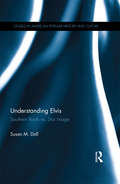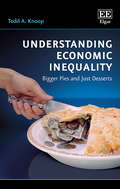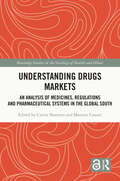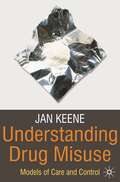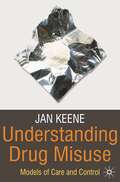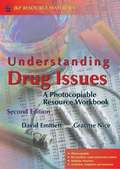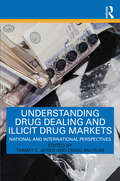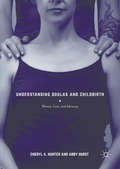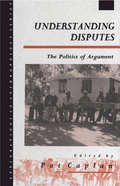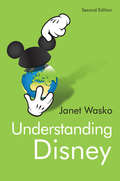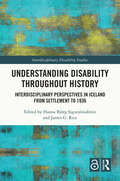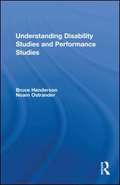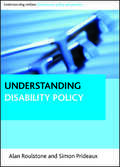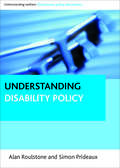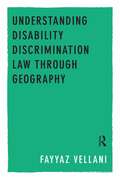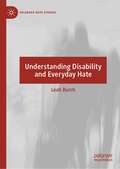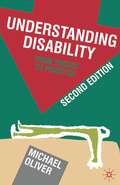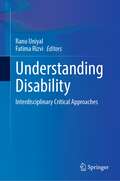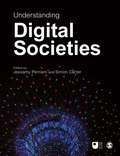- Table View
- List View
Understanding Elvis: Southern Roots vs. Star Image (500 Tips)
by Susan M. DollAlthough the importance of Elvis Presley's Southern heritage has long been recognized, few have considered the complex connection between the performer's career and his Southern roots. This study investigates how that identity affected each stage of Presley's career. Elvis Presley's career can be divided into three phases, each of which is signified by a specific image. Each image is coded by a certain style of music, mode of dress, and arena of performance. The evolution from one career phase to another was instigated by a specific event and represented a deliberate calculation on the part of Presley's manager to attract a wider audience. The first stage spans the years 1956 through 1958, after the singer was introduced to a national audience and before he was drafted into the army. His image as a notorious rock 'n' roller created a national controversy and was spurred by negative depictions of Presley in the media-many attributing his controversial performing style and appearance to his Southern background. His music was a fusion of rhythm and blues and country-western; or, two types of music indigenous to the South and foreign to the mainstream entertainment industry based in New York City. The second phase of Elvis' career included his stint as a movie star, in which most aspects of his Southern identity were extracted from his leading man image to enhance his appeal to the mainstream. And, finally, the last stage of his career focused on his image as a Las Vegas performer. Despite the gaudy costumes, Elvis reconnected to his identity as a Southerner in the 1970s by returning to country music and songwriters as a source of inspiration.
Understanding Economic Inequality: Bigger Pies and Just Desserts
by Todd A. KnoopOver the last 25 years, nearly two billion people across the globe have risen out of poverty and income levels have risen worldwide. Yet in the US, the top 1% earn twice the amount of income as the poorest 50% of the population. In the midst of rising prosperity, economic dissatisfaction—driven by the persistent fear felt by many that they are “falling behind”—is higher than at any point since the 1930s. In Understanding Economic Inequality, the author brings an economist’s perspective informed by new, groundbreaking research on inequality from philosophy, sociology, psychology, and political science and presents it in a form that it is accessible to those who want to understand our world, our society, our politics, our paychecks, and our neighbors’ paychecks better. As any history of the 21st century would be incomplete without understanding “the 99% versus the 1%”, the insights provided by the author will prove valuable to any reader. This book also provides the foundation for undergraduate courses on wealth and income inequality, and an essential reading for introductory economics, labor economics, public policy, law, or sociology courses.
Understanding Drugs Markets: An Analysis of Medicines, Regulations and Pharmaceutical Systems in the Global South
by Carine BaxerresDrawing on anthropology, historical sociology and social-epidemiology, this multidisciplinary book investigates how pharmaceuticals are produced, distributed, prescribed, (and) consumed, and regulated in order to construct a comprehensive understanding of the issues that drive (medicine) pharmaceutical markets in the Global South today. Based on primary research conducted in Benin and Ghana, and additional data collected in Cambodia and the Ivory Coast, this volume uses artemisinin-based combination therapies (ACTs) against malaria as a central case study. It highlights the influence of the countries colonial and post-colonial history on their models for state regulation, production, and distribution, explores the determining role transnational actors as well as industries from the North but also and increasingly from the South play in influencing local pharmaceutical markets and looks at the behaviour of health care professionals and individuals. Stepping back, the authors then unpick the pharmaceuticalization process and the multiple regulations at stake by looking at the workings of, and linkages between, (biomedical health) pharmaceutical systems, (representatives of companies) industries, actors in private distribution, and consumer practices. Providing a thorough comparative analysis of the advantages and disadvantages of different pharmaceutical systems, it is an important contribution to the literature on pharmaceutalization and the governance of medication. It is of interest to students, researchers and policy-makers interested in medical anthropology, the sociology of health and illness, global health, healthcare management and pharmacy. The Open Access version of this book, available at http://www.taylorfrancis.com/books/9780429329517, has been made available under a Creative Commons Attribution-Non Commercial-No Derivatives 4.0 license.
Understanding Drugs Markets: An Analysis of Medicines, Regulations and Pharmaceutical Systems in the Global South
by Carine Baxerres Maurice CassierDrawing on anthropology, historical sociology and social-epidemiology, this multidisciplinary book investigates how pharmaceuticals are produced, distributed, prescribed, (and) consumed, and regulated in order to construct a comprehensive understanding of the issues that drive (medicine) pharmaceutical markets in the Global South today. Based on primary research conducted in Benin and Ghana, and additional data collected in Cambodia and the Ivory Coast, this volume uses artemisinin-based combination therapies (ACTs) against malaria as a central case study. It highlights the influence of the countries colonial and post-colonial history on their models for state regulation, production, and distribution, explores the determining role transnational actors as well as industries from the North but also and increasingly from the South play in influencing local pharmaceutical markets and looks at the behaviour of health care professionals and individuals. Stepping back, the authors then unpick the pharmaceuticalization process and the multiple regulations at stake by looking at the workings of, and linkages between, (biomedical health) pharmaceutical systems, (representatives of companies) industries, actors in private distribution, and consumer practices. Providing a thorough comparative analysis of the advantages and disadvantages of different pharmaceutical systems, it is an important contribution to the literature on pharmaceutalization and the governance of medication. It is of interest to students, researchers and policy-makers interested in medical anthropology, the sociology of health and illness, global health, healthcare management and pharmacy. The Open Access version of this book, available at http://www.taylorfrancis.com/books/9780429329517, has been made available under a Creative Commons Attribution-Non Commercial-No Derivatives 4.0 license.
Understanding Drug Misuse: Models of Care and Control
by Jan KeeneKey to understanding drug misuse is an awareness of the full range of models that seek to define, explain and treat the problem. This book covers the full breadth of medical, social and psychological approaches to drug use, while retaining focus on the one question which is seldom asked: What do drug users themselves think? Based on extensive research, Understanding Drug Misuse offers comprehensive analysis of the diversity of drug-related problems, interwoven with frank – and often challenging – user perspectives. Combining theory and research evidence with extracts from the author's own interviews with drug users, this insightful text explores:drug use, drug dependence and discussion of maintenance versus abstinencehealth risks, harm minimization and public health solutionssocial harm, social exclusion, and problems of community safety and crimepractice implications for harm minimization, treatment, after-care and relapse preventionWith practical guidance that will inform all work directly related to drug policy or practice, Understanding Drug Misuse is an essential text for all students taking modules in substance abuse and addiction studies. It also makes fascinating and fundamental reading for specialist and generic workers in the health, social care and criminal justice professions.
Understanding Drug Misuse: Models of Care and Control
by Jan KeeneKey to understanding drug misuse is an awareness of the full range of models that seek to define, explain and treat the problem. This book covers the full breadth of medical, social and psychological approaches to drug use, while retaining focus on the one question which is seldom asked: What do drug users themselves think?Based on extensive research, Understanding Drug Misuse offers comprehensive analysis of the diversity of drug-related problems, interwoven with frank – and often challenging – user perspectives. Combining theory and research evidence with extracts from the author's own interviews with drug users, this insightful text explores: - Drug use, drug dependence and discussion of maintenance versus abstinence- Health risks, harm minimization and public health solutions- Social harm, social exclusion, and problems of community safety and crime- Practice implications for harm minimization, treatment, after-care and relapse preventionWith practical guidance that will inform all work directly related to drug policy or practice, Understanding Drug Misuse is an essential text for all students taking modules in substance abuse and addiction studies. It also makes fascinating and fundamental reading for specialist and generic workers in the health, social care and criminal justice professions.
Understanding Drug Issues: A Photocopiable Resource Workbook Second Edition (PDF)
by David Emmett Graeme NiceThis fully updated edition of a successful resource succeeds in engaging and involving young people where many other methods of drugs education - including attempts to shock, inform, or promote decision-making - have failed to make a lasting impact. This is largely because they don't utilize young people's own views, intelligence and insight. The range of 30 original exercises in this resource is designed to expand and challenge participants' understanding of the issues surrounding illegal drug use, with activities that will enable them to make active and informed personal judgements about drugs. Understanding Drug Issues features informative and balanced material on all the key issues involved, including: * the facts and fiction about drugs * peer pressure * the social consequences of drug use * buying drugs * the dangers involved in using * the pros and cons of drug use * legal implications * the effects of drugs on health. The activities are ideal for use in groups and feature all the latest developments surrounding the use and abuse of drugs, as well as useful contact details for those wanting further help. The material is photocopiable and designed to be used flexibly - for example as worksheets or overhead projections. Understanding Drug Issues is an essential resource that will be valued by teachers, youth workers, probation officers, those working with offenders, and any professionals working with young people. This workbook can be used on its own, or ideally in combination with its companion volume Understanding Drugs: A Handbook for Parents, Teachers and Other Professionals, a complete reference on drugs issues (second edition forthcoming, September 2005).
Understanding Drug Dealing and Illicit Drug Markets: National and International perspectives
by Tammy C Ayres Craig AncrumThis book examines the drug dealer in contemporary society from an interdisciplinary perspective and considers the increasingly blurred demarcation between illegitimate and legitimate drug markets. It explores the motives and drivers of those involved in drug supply and dispels common and stereotypical myths and misconceptions surrounding illegal drug markets and those who operate within them. The drug dealer has become one of our foremost contemporary ‘folk devils’. Those who trade in substances prohibited by law are the subject of array of inaccurate myths and urban legends. Criminology has tended either to shoehorn drug dealers into neat typologies or portray them as ‘victims’ of an uncaring, predatory post-modern society. In reality, we know relatively little about the complex and diverse world of drug markets and our concentration inevitably falls on low-end ‘retail’ dealers who operate in the most visible sectors of the illegal economy. Bringing together an international group of experts, this book considers perspectives from around the world, including UK, USA, South America, Spain, India and Australia. This book will be of interest to students and researchers across criminology, law, sociology, criminal justice and public health, and will be essential reading for those taking courses on drugs, drug markets and substance misuse.
Understanding Drug Dealing and Illicit Drug Markets: National and International perspectives
This book examines the drug dealer in contemporary society from an interdisciplinary perspective and considers the increasingly blurred demarcation between illegitimate and legitimate drug markets. It explores the motives and drivers of those involved in drug supply and dispels common and stereotypical myths and misconceptions surrounding illegal drug markets and those who operate within them. The drug dealer has become one of our foremost contemporary ‘folk devils’. Those who trade in substances prohibited by law are the subject of array of inaccurate myths and urban legends. Criminology has tended either to shoehorn drug dealers into neat typologies or portray them as ‘victims’ of an uncaring, predatory post-modern society. In reality, we know relatively little about the complex and diverse world of drug markets and our concentration inevitably falls on low-end ‘retail’ dealers who operate in the most visible sectors of the illegal economy. Bringing together an international group of experts, this book considers perspectives from around the world, including UK, USA, South America, Spain, India and Australia. This book will be of interest to students and researchers across criminology, law, sociology, criminal justice and public health, and will be essential reading for those taking courses on drugs, drug markets and substance misuse.
Understanding Doulas and Childbirth: Women, Love, and Advocacy
by Cheryl A. Hunter Abby HurstThis book contextualizes how having a doula, or labor-support woman, present during childbirth results in lower rates of medical interventions. American women are inundated with views that childbirth is inherently risky, their bodies deficient, and therefore encouraged to accept the medicalized nature of childbirth resulting in high rates of unwarranted interventions that can pose significant risk in a normal pregnancy. Why is birthing with a doula different? The narratives in this book support the belief that doulas often question the high rates of medical interventions in childbirth, fundamentally lodging a critique about the medicalization of childbirth to the women they serve. These stories share a very different philosophy about childbirth; one where the female body is capable, resilient, and not normally requiring external medical intervention. Doulas enter into a care-provider relationship that focuses on the experience of the birth as something transformative, to be honored and centered on the woman’s body in an active role in the process. Lastly, doulas model to their clients both love and advocacy because doulas believe that modeling these behaviors will translate as women become mothers through the process of childbirth.
Understanding Disputes: The Politics of Argument
by Pat CaplanAre disputes ever really resolved, or do people need to find ways of accommodating them and living with the consequences? Can dispute settlement procedures at the local level be transferred to wider environments? In attempting to answer these questions, some of the foremost specialists in the anthropology of law and disputing behaviour examine how people in a variety of social settings, ranging from Ireland to East Africa, deal with quarrels and seek to resolve or accommodate them. This stimulating volume should be of interest to anyone concerned about the increase in conflict in many parts of the world.
Understanding Disputes: The Politics of Argument (Explorations In Anthropology Ser.)
by Pat CaplanAre disputes ever really resolved, or do people need to find ways of accommodating them and living with the consequences? Can dispute settlement procedures at the local level be transferred to wider environments? In attempting to answer these questions, some of the foremost specialists in the anthropology of law and disputing behaviour examine how people in a variety of social settings, ranging from Ireland to East Africa, deal with quarrels and seek to resolve or accommodate them. This stimulating volume should be of interest to anyone concerned about the increase in conflict in many parts of the world.
Understanding Disorganized Attachment: Theory and Practice for Working with Children and Adults
by David Shemmings Yvonne ShemmingsDisorganized attachment can develop in a child when the person who is normally meant to protect them is a source of danger. This book is a comprehensive and accessible text on disorganized attachment. It outlines what it is, how it can be identified and the key causes, including neurological, biochemical and genetic explanations.
Understanding Disney: The Manufacture of Fantasy
by Janet WaskoSince the 1930s, the Walt Disney Company has produced characters, images, and stories that have captivated audiences around the world. How can we understand the appeal of Disney products? What is it about the Disney phenomenon that attracts so many children, as well as adults? In this updated second edition, with new examples provided throughout, Janet Wasko examines the processes by which the Disney company – one of the largest media and entertainment corporations in the world – continues to manufacture the fantasies that enthrall millions. She analyses the historical expansion of the Disney empire into the twenty-first century, examines the content of Disney’s classic and more recent films, cartoons and TV programs and discusses how they are produced, considering how some of the same techniques have been applied to the Disney theme parks. She also discusses the reception (and sometimes, reinterpretation) of Disney products by different kinds of audiences. By looking at the Disney phenomenon from a variety of perspectives, she provides an updated and comprehensive overview of one of the most significant media and cultural institutions of our time. This important book by a leading scholar of the entertainment industries will be of great interest to students in media and cultural studies, as well as a broader readership of Disney fans.
Understanding Disability Throughout History: Interdisciplinary Perspectives in Iceland from Settlement to 1936 (Interdisciplinary Disability Studies)
by Hanna Björg Sigurjónsdóttir James G. RiceUnderstanding Disability Throughout History explores seldom-heard voices from the past by studying the hidden lives of disabled people before the concept of disability existed culturally, socially and administratively. The book focuses on Iceland from the Age of Settlement, traditionally considered to have taken place from 874 to 930, until the 1936 Law on Social Security (Lög um almannatryggingar), which is the first time that disabled people were referenced in Iceland as a legal or administrative category. Data sources analysed in the project represent a broad range of materials that are not often featured in the study of disability, such as bone collections, medieval literature and census data from the early modern era, archaeological remains, historical archives, folktales and legends, personal narratives and museum displays. The ten chapters include contributions from multidisciplinary team of experts working in the fields of Disability Studies, History, Archaeology, Medieval Icelandic Literature, Folklore and Ethnology, Anthropology, Museum Studies, and Archival Sciences, along with a collection of post-doctoral and graduate students. The volume will be of interest to all scholars and students of disability studies, history, medieval studies, ethnology, folklore, and archaeology.
Understanding Disability Throughout History: Interdisciplinary Perspectives in Iceland from Settlement to 1936 (Interdisciplinary Disability Studies)
by Hanna Björg Sigurjónsdóttir James G. RiceUnderstanding Disability Throughout History explores seldom-heard voices from the past by studying the hidden lives of disabled people before the concept of disability existed culturally, socially and administratively. The book focuses on Iceland from the Age of Settlement, traditionally considered to have taken place from 874 to 930, until the 1936 Law on Social Security (Lög um almannatryggingar), which is the first time that disabled people were referenced in Iceland as a legal or administrative category. Data sources analysed in the project represent a broad range of materials that are not often featured in the study of disability, such as bone collections, medieval literature and census data from the early modern era, archaeological remains, historical archives, folktales and legends, personal narratives and museum displays. The ten chapters include contributions from multidisciplinary team of experts working in the fields of Disability Studies, History, Archaeology, Medieval Icelandic Literature, Folklore and Ethnology, Anthropology, Museum Studies, and Archival Sciences, along with a collection of post-doctoral and graduate students. The volume will be of interest to all scholars and students of disability studies, history, medieval studies, ethnology, folklore, and archaeology.
Understanding Disability Studies And Performance Studies (PDF)
by Bruce B. Henderson Noam OstranderThis collection brings together scholarship and creative writing that brings together two of the most innovative fields to emerge from critical and cultural studies in the past few decades: Disability studies and performance studies. It draws on writings about such media as live performance art, photography, silent film, dance, personal narrative and theatre, using such diverse perspectives and methods as queer theory, gender, feminist, and masculinity studies, dance studies, as well as providing first publication of creative writings by award-winning poets and playwrights. This book was based on a special issue of Text and Performance Quarterly.
Understanding disability policy (Understanding Welfare: Social Issues, Policy and Practice series)
by Alan Roulstone Simon PrideauxIn an era of scarce social resources the question of the changing social policy constructions and responses to disabled people has become increasingly important. Paradoxically, some disabled people are realising new freedoms and choices never before envisioned, whilst others are prey to major retractions in public services and aggressive attempts to redefine who counts as 'genuinely disabled'. Understanding disability policy locates disability policy into broader social policy and welfare policy writings and goes beyond narrow statutory evaluations of welfare to embrace a range of indicators of disabled people's welfare. The book critically explores the roles of social security, social support, poverty, socio-economic status, community safety, official discourses and spatial change in shaping disabled people's opportunities. It also situates welfare and disability policy in the broader conceptual shifts to the social model of disability and its critics. Finally it explores the possible connection between changing official and academic constructions of disability and their implications for social policy in the 21st century. The book is supported by a companion website, containing additional materials for both students and lecturers using the book, which is available from the link above.
Understanding disability policy (Understanding Welfare: Social Issues, Policy and Practice series)
by Alan Roulstone Simon PrideauxIn an era of scarce social resources the question of the changing social policy constructions and responses to disabled people has become increasingly important. Paradoxically, some disabled people are realising new freedoms and choices never before envisioned, whilst others are prey to major retractions in public services and aggressive attempts to redefine who counts as 'genuinely disabled'. Understanding disability policy locates disability policy into broader social policy and welfare policy writings and goes beyond narrow statutory evaluations of welfare to embrace a range of indicators of disabled people's welfare. The book critically explores the roles of social security, social support, poverty, socio-economic status, community safety, official discourses and spatial change in shaping disabled people's opportunities. It also situates welfare and disability policy in the broader conceptual shifts to the social model of disability and its critics. Finally it explores the possible connection between changing official and academic constructions of disability and their implications for social policy in the 21st century. The book is supported by a companion website, containing additional materials for both students and lecturers using the book, which is available from the link above.
Understanding Disability Discrimination Law through Geography
by Fayyaz VellaniExamining the UK Disability Discrimination Act (DDA) in comparison to its counterparts in the USA and Australia, this book focuses on how it is being interpreted and acted upon in the context of higher education, a key area of national attention in the UK. It also evaluates this law in the context of the larger project of civil rights legislation and demonstrates that geography can be used to explain law and legal arguments by highlighting their subjectivity and by emphasizing the importance of place, specificity and context. While providing in-depth analysis of the effectiveness and scope of this significant legislation this book demonstrates the importance of geography in the application of law. It provides insights into the broader workings of UK anti-discrimination law, which are particularly relevant given the scrutiny of the Equality and Human Rights Commission and the concerns about the effectiveness of legal tools in fighting discrimination. Finally, this book critiques liberal notions of legal subjectivity and medical definitions of disability which is topical given the current attention given to debates about identity politics.
Understanding Disability Discrimination Law through Geography
by Fayyaz VellaniExamining the UK Disability Discrimination Act (DDA) in comparison to its counterparts in the USA and Australia, this book focuses on how it is being interpreted and acted upon in the context of higher education, a key area of national attention in the UK. It also evaluates this law in the context of the larger project of civil rights legislation and demonstrates that geography can be used to explain law and legal arguments by highlighting their subjectivity and by emphasizing the importance of place, specificity and context. While providing in-depth analysis of the effectiveness and scope of this significant legislation this book demonstrates the importance of geography in the application of law. It provides insights into the broader workings of UK anti-discrimination law, which are particularly relevant given the scrutiny of the Equality and Human Rights Commission and the concerns about the effectiveness of legal tools in fighting discrimination. Finally, this book critiques liberal notions of legal subjectivity and medical definitions of disability which is topical given the current attention given to debates about identity politics.
Understanding Disability and Everyday Hate (Palgrave Hate Studies)
by Leah BurchThis book examines disability hate crime. It focusses on key questions concerning the ways in which hate is understood and experienced within the context of the everyday, in addition to the unique ways that hate can hurt and be resisted. It introduces readers to questions surrounding the conceptual framework of hate and policy context in England and Wales, and extends these discussions to center upon the experiences of disabled people. It presents a conceptual reconsideration of hate crime that connects hate, disability and everyday lives and spaces using an affective (embodied and emotional) understanding of these experiences. Drawing on empirical data, this framework helps to attend to the diverse ways that disabled people negotiate, respond to, and resist hate within the context of their everyday lives. The book argues that the affective capacity of disabled people can be enhanced through their reflections upon hateful experiences and general experiences of navigating a disabling social world. By working with the concept of ‘affective possibility’, this book offers a more affirmative approach to harnessing the everyday forms of resistance already present within disabled people’s lives. It speaks to academics, students, and practitioners interested in disability, affect studies, hate crime studies, sociology, and criminology.
Understanding Disability: From Theory to Practice
by Michael OliverIn this absorbing text by a leading writer and respected activist, theory, policy, historical background and personal experience are combined to give readers a rich and illuminating picture of the key issues raised by disability. In the author's uniquely clear and lively narrative style, the book explores:the practical and political challenges that disablement presentstheoretical understandings of disabilitydisability law and the realities of policy implementationkey points of contention for the disability movementThis long-awaited new edition of a best-selling text includes new stories from the author's experience, as well as sharply framed debate aboutthe development of policy over the last decade and a half. Its expansive coverage includes discussion of welfare, rehabilitation, special education and normalization. This book is core reading for students of social work, nursing, health and applied social science taking modules in disability studies. Michael Oliver was the first Professor of Disability Studies in the United Kingdom and is Emeritus Professor of Disability Studies at the University of Greenwich, UK. He is the author of the path-breaking The Politics of Disablement and Social Work with Disabled People (in its third edition, co-authored with Bob Sapey).
Understanding Disability: Interdisciplinary Critical Approaches
by Ranu Uniyal Fatima RizviThis edited volume brings together contributions on disability studies organized around two themes: literary and sociological aspects. The contributors include academics, disability activists, and researchers from within and outside the Indian periphery. While the book strengthens the disability discourse and contributes to building academic scholarship on this subject, it also promotes disability activism by giving space to both direct practitioners and persons with disabilities. The chapters discuss various analytical and literary aspects of the marginalization experienced by the disabled community and bring forth new and elaborate perspectives. It draws connections across multiple identities and includes personal narratives across nations, cultures and societies. It is an excellent research resource on disability studies in India for scholars and students in the area of humanities, education, law, sociology and social work, while at the same time also addressing the global context.
Understanding Digital Societies (Published in association with The Open University)
by Jessamy Perriam Simon CarterUnderstanding Digital Societies provides a framework for understanding our changing, technologically shaped society and how sociology can help us make sense of it. You will be introduced to core sociological ideas and texts along with exciting global examples that shed light on how we can use sociology to understand the world around us. This innovative, new textbook: Provides unique insights into using theory to help explain the prevalence of digital objects in everyday interactions. Explores crucial relationships between humans, machines and emerging AI technologies. Discusses thought-provoking contemporary issues such as the uses and abuses of technologies in local and global communities. Understanding Digital Societies is a must-read for students of digital sociology, sociology of media, digital media and society, and other related fields.
